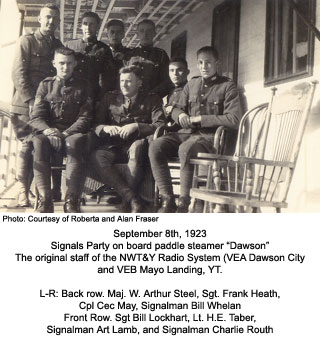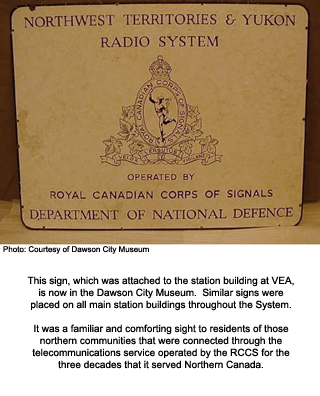The story of the NWT&Y Radio System is a virtually unknown
saga in the history of the development of northern Canada. The contributions
of the men who staffed the stations are largely unheralded. In his
post-script to this short chronology the author says,
"Northerners
will also remember Signals primarily as magistrates, Airways and
Transportation agents, acting minions of the law and prime movers
in community affairs. It is the unmistakeable fact that the fine
reputation built by RC Signals during 37 eventful years of service
in the yet-to-be-fully-exploited north country was not the result
of the efforts of one, two or even three individuals, but rather
the results of the combined efforts of every officer and man who
served on this now non-existent arm of the Royal Canadian Corps
of Signals."
These
are not the normal roles of soldiers on active service. But here
in the Canadian northland they were engaged in unusual circumstances
and eventful times. Not only was Canada's northern frontier and
its resources in the early stages of exploration and development,
but the science, technology and practical applications of global
telecommunications and air transportation were also probing new
frontiers. The Royal Canadian Corps of Signals was asked by the
Government of Canada to step into the breach and fill the void in
long-distance telecommunication to serve those industries and the
embryonic communities in the northern territories. In the process
the Signallers found themselves, perforce, fulfilling duties far
beyond anything they had learned at the School of Signals in Vimy
Barracks. In enthusiasm, ability, dedication and inventiveness they
were not found wanting. In the nearly four decades that their System
operated they left behind them a proud and impressive legacy.
The
following text is from two manuscripts held by the C&E Museum
- the original and a slightely edited version. The author is WO1
"Cal" Vince (Retd). The original manuscript, dated June
1960, is presented here with only very minor edits to correct the
tense in a few places, and the deletion of some personal observations
that were left out by an earlier editor.
A
Short History
of the
Northwest Territories and Yukon Radio System
by
WO1 Cal Vince
Foreword
The aim in preparing
this concise history of the Northwest Territories and Yukon Radio
system was an attempt to record the highlights of events in a chronological
order, so that those interested in the System may obtain a clearer
view of the functions and responsibilities the Corps assumed when
given the task of establishing and operating the System.
The Radio System was known in the communication field as an efficient,
reliable and rapid means of communication throughout the vast Northland.
the high standard of operating and low error factor speaks well of
the men who were employed on the System.
Witn the loss of the System the Signal Corps regretably lost a most
valuable method of training Signals personnel in maintaining equipment
and the art of passing trraffic efficiently. It also taught men to
be self-reliant and readily accept responsibility, which in turn provided
excellent NCOs and officers of the Corps.
Prelude
In
1922, the vast Canadian north, from Hudson Bay to the Alaska border,
comprising of the Northwest Territories and the Yukon Territory, had
no means of communication with civilization, or "outside"
as it was known, except a limited mail service by boat in summer and
dog-team in winter. In addition to this limited mail service Dawson
City, YT was served by a telegraph line from Hazelton, BC operated
by the Dominion Government Telegraph Service. The telegraph line was
none too reliable due mainly to maintenance difficulties as it ran
for hundreds of miles through uninhabited wilderness and over extremely
rugged terrain.
Go
to Chronologies
1923-1929
1930-1939 1940-1949
1950-1960
-------------------------------------------------------------------------------------------------
Back
to Top of Page
For
sidebar stories on life in the North during those years go to:
Stories Page | Special
Events Page | Vignettes
Page





